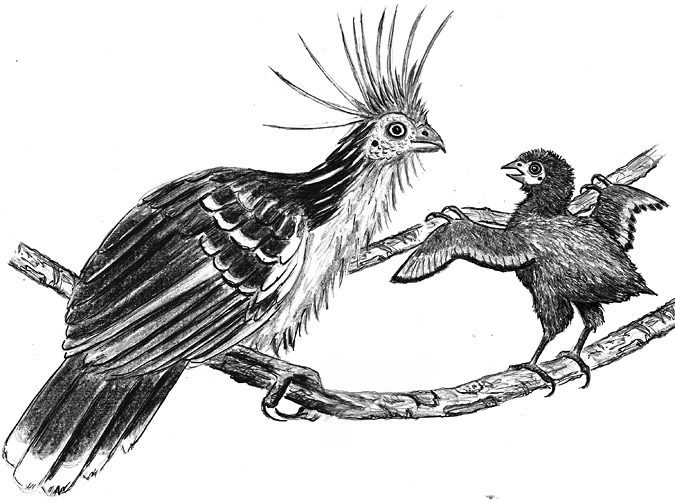
Dear Bird Folks,
Recently I watched a nature show that talked about a particular bird that has claws on its wings, much like bats do. However, I can’t remember the name of the bird. How you ever heard of this bird?
– Ian, Boston, MA
Bad timing, Ian,
Why didn’t you send me this question two weeks ago? It would have been perfect for Halloween. A bird with bat-wing claws is a spooky topic all by itself, but it’s not the freaky wing-claws that make it so frightening. It’s the bird’s name. The bird you are talking about is called “Hoatzin” and it’s a nightmare trying to pronounce it. Every time I say “Hoatzin” I pronounce it differently. Go ahead, Ian, try to say it. Let’s see how you do. I’ll give you a few minutes. Good luck. According to Dictionary.com, Hoatzin is pronounced ho-at-sin. Is that what you said? No, of course it isn’t. Here’s what to do. First say “ho,” just like ho, ho, ho. The next syllable is “at,” as in: Where you at? The last syllable is “sin.” You won’t need any help with that. Put them all together and you have ho-at-sin, or Hoatzin. Don’t blame me; I didn’t name it.
If you think the pronunciation of this bird’s name is strange, wait until you hear about the rest of it. Hoatzins are rather tame birds that are found in the Amazon area of South America. They have extended tails and extra-long necks, which hold up their somewhat puny heads. But what the Hoatzin’s head lacks in size, it more than makes up for in ornateness. The bird’s featherless face is bright blue and the eyes are deep red, looking like a cross between Satan and a Smurf. In addition, the head is topped with a cinnamon crest (the color cinnamon, not the delicious spice), which has long spiky plumes, giving the bird the best punk-do ever. The books say that the Hoatzin has the look of a pheasant, but the bird reminds me of a roadrunner/dragon hybrid. Check out a picture of one and see who’s right.
Unlike roadrunners (and dragons), which spend most of their lives on the ground, Hoatzins are tree-loving birds that like to crawl about on branches eating flowers and fruit. But what the birds really crave are leaves, which make up about 82% of their daily diet. And in case you care, or do crossword puzzles or are just plain geeky, the word for leaf-eating creatures is “folivore.” Don’t ask me how to pronounce it. We’ve already had enough phonics lessons for one day. The advantage of having a leaf-rich diet is obvious. The birds simply wake up each morning, walk out on a branch and start chewing. However, in order to digest large quantities of leaves the Hoatzins have evolved several physiological adaptations. One of these adaptations is an oversized crop. The crop not only holds the leaves, but it also secretes enzymes that help begin the digestive process. It may be the only bird in the world with this distinctive cow-like digestive system. Thus, Hoatzins are also like cows, plus roadrunners, dragons, Satan and Smurfs. This odd digestive system allows the birds to take advantage of the Amazon’s abundant foliage, but it comes with a price. The supersized crop displaces many of the birds’ flight muscles and thus Hoatzins are weak flyers. When traveling from tree to tree, they tend to glide, flying squirrel style, instead of flapping, normal bird style. You might think that such colorful, tame birds with poor flight skills would be easy targets for human hunters. But Hoatzins have yet another odd thing going for them: they stink.
As you might imagine, a crop filled with fermenting leaves doesn’t smell like Irish Spring. In fact, Hoatzins have such a displeasing odor (and flavor) human hunters avoid them…except for hunters with anosmia, which is the lack of the ability to smell. (Gee, I wish my feet had that). However, this doesn’t mean Hoatzins don’t have enemies. A bad smell won’t deter hawks or other predators, so Hoatzins, particularly baby Hoatzins, have another clever trick up their sleeves (if they had sleeves, that is).
Hoatzins build their nests on tree branches that hang out over the water. If danger approaches, the flightless chicks take matters into their own hands (if they had hands, that is) and crawl out of their nest and drop into the water below. The babies then swim to the nearest vegetation and hide until the danger passes. Next, the little birds climb out of the water and up a tree. That’s right, they climb. Around here, when a baby robin or baby cardinal falls out of its nest, it just sits and squawks with no ability to help itself. But the baby Hoatzins have something robins and cardinals don’t have. They have claws on their wings, which allow them to grip tree branches and pull themselves up and out. Our lazy baby robins and cardinals need to grow some of these wing-claws and stop all of that useless squawking.
Yes, Ian, your TV show didn’t lie; Hoatzins have bat-like claws on their wings. But unlike bats, the claws on these birds are for the babies only. As they get older, the claws disappear and the Hoatzin becomes a normal bird…well, except for the blue face, red eyes punk-do, leaf-eating habit, nasty smell, cow digestive system and, of course, it’s crazy name. Other than that, Hoatzins are no different than any other bird.